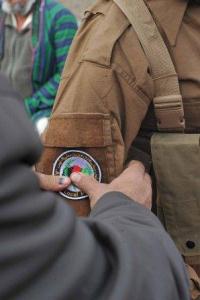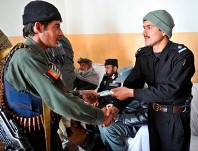|
Afghan Local Police (ALP) |
|||||||||
|
General Information
Books on Afghanistan
|
Afghan War News > Security > Afghan Local Police News
Articles about the Afghan Local Police
Establishment of the Afghan Local Police. The Afghan Local Police was established by President Karzai in the summer of 2010 as a part of the Ministry of Interior. On July 4, 2010 General Patraeus received approval from President Karzai for the establishment of the ALP. A presidential decree followed by memorandums from the Ministry of Interior made it official. The ALP are trained, advised, and supported by special operations teams of the CJSOTF-A. However, the ALP are part of the Ministry of Interior (MoI) and receives pay and equipment from the MoI. Command of ALP. Although it receives training and advice from CFSOCC-A, the ALP falls under the command of the Ministry of Interior through its provincial and district level chain of command. The first ALP commander was Major General Gul Nabi Ahmadzai. ALP units at the village level will have its commanders selected by the regional or district level ANP commander. 3. ALP as a part of Village Stability Operations or VSO. Village Stability Operations or VSO is a major effort of CFSOCC-A that is comprised of three main operational goals. These goals are the establishment of security, governance, and development in selected areas of Afghanistan. The Afghan Local Police is a big part of the VSO security effort in some of these rural, austere, and remote areas where the special operations forces operate. These VSO areas tend to coincide with areas that the conventional forces of ISAF and the Afghan ANA and ANP do not effectively operate and where ties to the provincial and national government are weak. See "In Faryab province, Village Stability Operations show success", DVIDS, October 13, 2011 and "Taking a Stand: Village Stability Operations and the Afghan Local Police", Special Warfare Magazine, July-September 2011. The ALP program is a complement to the VSO program. Although not all VSO sites have Afghan Local Police; all ALP locations work in conjunction with VSO sites. Tthis is true only with CFSOCC-A mentored ALP locations; not so true with Regional Command ALP programs and unilateral ALP locations set up by the MoI. ALP and Partnering Units. In most cases, ALP are partnered with special operations forces working with CFSOCC-A. In a small number of instances the ALP may be partnered with conventional U.S. forces (who unfortunately do not adopt the VSO methodology) and other ISAF units (both conventional and SOF). There are a few instances of ALP units established by the Ministry of Interior who are not "partnered" at all; which leads to problems. Some of these un-partnered units tend to look and act more like militias - therefore leading to inaccurate accusations that ISAF is re-establishing militias in Afghanistan. Funding for Afghan Local Police. Initially funding was provided for the establishment of the ALP through the use of Commander's Emergency Response Program or CERP funds. (For an explanation of CERP see "The Commander's Emergency Response Program", by Mark S. Martins, Joint Force Quarterly, issue thirty seven). CERP paid for the salaries and other initial expenses. As the program matured the Ministry of Interior began paying the salaries of the ALP members and providing weapons, ammunition, uniforms, vehicles, radios, and other logistical support using Afghan Security Forces funds. As with anything in Afghanistan - this MoI support is problematic due to inefficiency, corruption, lack of staff training, experience, and capacity, and the meddling of higher level Afghan government officials. Bottom Up vs. Top Down Solutions for
Afghanistan. The Afghan Local Police (and the overarching
Village Stability Operations program) is an example of a "bottom up"
approach to providing solutions to the Afghanistan problem.
Afghanistan has a history of weak central governments that exert minimal
rule over its diverse ethnic population. The weak control is
especially acute in the more remote areas located in mountainous terrain
or rural areas away from the "ring road" and larger cities. History
shows that a weak central government can survive if it relies on local
communities to band together to solve its problems without interference
from a central government from Afghanistan. For more on this concept of
"bottom up" security solutions see works by
Dr. Seth Jones entitled In the Graveyard of Empires: America's War in Afghanistan Arbakai. Afghanistan has a history of local solutions to the lack of a strong central government. The bast majority of Afghan central governments have failed in providing security to its population that is located away from the major cities; the present Karzai regime is no exception. Many communities form "Arbakai" or local defense militias. The ALP program borrows some of its fundamentals from this Arbakai security system. For more on Arbakai see "Tribal Security System (Arbakai) in Southeast Afghanistan", by Mohammed Osman Tariq (December 2008). Arbakai still exists in Afghanistan and many times these Arbakai are mistakenly called ALP - providing more confusion about the Afghan Local Police. Selection of ALP Locations. The methodology of site selection for ALP units is stringent. The local community must form (or have in existence) a jirga or shura that is representative of the district - which in turn form district level community councils. This shura is vetted by the Independent Directorate of Local Governance using the Afghanistan Social Outreach Program. Once the local community or district shura is formed, vetted and trained (by ASOP) then the concept of local defense in the form of the Afghan Local Police is voted on by the shura. See "ASOP assists district leadership with elections in Khas Uruzgan", DVIDS, October 31, 2010. If the community accepts the forming of and promises support to the ALP then the Ministry of Interior is approached for a tashkeel (organizational structure that authorizes pay and equipment) for the community. Once a tashkeel is approved then recruitment can begin. Plans are that over 70 districts (possibly 100) will have an ALP force of about 300 members. Recruitment of ALP. Members of the local ALP unit must be recruited from the local area or district. The recruits must be between the ages of 18 and 45. They are vetted by the local community or district shura (community leadership structure) and sometimes referred to as "sons of the village". 6. Once vetted they meet with the district or provincial Ministry of Interior Afghan National Police recruiter and fill out an application. The application is approved by the provincial government and submitted to the Ministry of Interior at Kabul. If the application is accepted then an MoI biometrics team enrolls the candidate and a background check is conducted. 2. If the candidate passes he then signs a one-year contract with the MoI and can commence his training, be issued uniforms and a weapon, and start receiving pay. Shura Validation of ALP Force. A subsequent shura is then held to validate the community's support for the future ALP force. This shura is attended by elders, district and provincial government officials and other Afghan government officials. Training of the ALP candidates commences shortly after this shura. See "ALP shura held in Dahana-E-Ghori", DVIDS, October 18, 2011. Training of ALP. The initial training of members of an ALP unit takes place within the district or province where they live and where they will operate. The training - at least in 2011 - was three weeks long and conducted, in the vast majority of cases, by special operations teams of the CJSOTF-A. Training consists of the use of weaponry, basic rifle marksmanship, rule of law, searches and seizures, battle drill, medical training, basic police tactics, and other associated tasks. See "New Afghan Local Police start first day of training", DVIDS, October 28, 2011. In addition to training conducted by SOF teams the ALP recruits also receive training from Afghan National Police 5 and Afghan National Army Special Forces (ANASF) 7.
Limited ALP Authority. The legal powers of the ALP is limited when compared to other organizations within the Ministry of Interior. The ALP does not have the authority to arrest people but can detain individuals and turn them over to the Afghan National Police (ANP) or Afghan National Army (ANA). In addition, the ALP is a "self-defense force" and cannot conduct offensive operations unless it is local in nature and in response to a local threat to the small geographical area they are protecting. Typically, the ALP do not operate outside of their community or district. The commanders of the ALP units report to the district Chiefs of Police (ANP). Advanced Training of ALP. Once the initial three-week training course for the ALP is completed the ALP candidates assume their duties. They continue to be mentored, advised, and trained by partnered SOF detachments of CFSOCC-A. The Afghan National Army's special operations forces (ANA Commandos and ANA Special Forces) are developing an increased capabilty to work with the ALP as well. Additionally, units of the Afghan National Police (ANP) and Afghan National Army (ANA) provide training to the ALP. See "ALP train with ANP to bridge gaps and prepare for future", DVIDS, October 28, 2011 and "Afghan Commandos provide marksmanship training to Gizab's ALP", DVIDS, December 18, 2011. Equipment of ALP. The ALP carries weapons such as the AK-47 but it is not allowed to carry heavy weapons such as machine guns. All equipment is supplied by the Ministry of Interior, funded by the United States through ANSF funds. Literacy Training for ALP. Many of the ALP recruits, because of the rural and remote nature of their geographical location, do not know how to read or write. Where feasible literacy training is being introduced through the ANSF Literacy Program. See "Literacy Program taught to Afghan Local Police in Uruzgan Province", DVIDS, December 10, 2011. In addition, some ALP units are advancing literacy in their own villages. See "Communities embrace literacy program throughout Afghanistan", DVIDS, November 10, 2011.
Is ALP Just Another Militia? Many critics of the Afghan Local Police accuse the ALP program of establishing local "militias" that are beyond the control of the Afghan central government. See a recent report by the Human Rights Watch (HRW) entitled Just Don't Call It A Militia: Impunity, Militias, and the "Afghan Local Police" published in September 2011. Many of the allegations are not valid; see an ISAF report of an AR 15-6 investigation into the allegations raised by the HRW report here - ISAF Memorandum on HRW ALP Report (December 6, 2011). There are imperfections in the ALP program, as the ISAF report does acknowledge; however, they are vastly overshadowed by the success of the ALP and VSO endeavors. Overlooked by HRW and other critics is the fact that the ALP is a Ministry of Interior (MoI) police organization paid for and supervised by the MoI; with oversight from the district Afghan National Police (ANP) as well as ISAF or CFSOCC-A elements.
Confusing ALP with other Local Defense Forces and Militias. Many reports of abuse attributed to the Afghan Local Police are actually reports of abuse committed by non-ALP local defense forces such as local arbakai, warlord militias, crime gangs, unofficial organizations found in remote provinces that have taken the ALP name, road maintenance security crews, and other private security organizations paid by NGOs, implementing partners or through CERP funding for specific security purposes (ISCI, CIP, etc.). Confusion is abundant as to what is an ALP unit. Many times abuses cited by organizations such as HRW are committed by arbakai or warlord militias. HRW and other organizations frequently lump these militia organizations together and apply the name Afghan Local Police. Some district governors are calling their local militias or defense forces "ALP" even though they are not part of the Ministry of Interior and have not been sanctioned as ALP. Acceptance of the ALP. The existance of the Afghan Local Police has generated much support and constant warnings. The international community - especially NGOs, humanitarian organizations, and other non-governmental actors - has have been very disapproving. 4. The Afghan government approved the ALP concept only after some serious discussions between General Patraeus and President Karzai. Many conventional U.S. commanders (bn and bde level) see the ALP as another "Special Forces project" that will sap time, energy and resources from the main effort of the war. The ALP did have the very strong support of General McCrystal and General Patraeus. It remains to be seen how well General Allen will support the ALP. The Afghan population in general is concerned that the ALP will be just another militia that will fall under the control of regional warlords or crime gangs. Others are fearful of yet another Afghan police organization that is corrupt and predatory in nature - the ANP is generally not held in high regard. Growth of ALP. In December 2011 Admiral McRaven, the commander of United States Special Operations Command (USSOCOM), announced that the size of the Afghan Local Police would be increased from its current strength of 10,000 to 30,000. This announcement was met with enthusiasm by many COIN observers and dismay by some critics and NGOs. The growth of the ALP is seen by ISAF of one of several key actions to build support for the central Afghan government in remote and rural areas and which will aid in the transition of security functions from ISAF to the Afghan government. ALP Absorbing other Security Programs. Some other security programs are being absorbed by the ALP - to include APPF (or AP3), CIP, ISCI, and CBSS. 1 Transition of ALP in the Future. Many questions remain as to the future of the ALP. For now it is envisioned to remain in place for 3-5 years - a few years past 2014. Some say that the ALP will remain as a permanent part of the security solution for Afghanistan staying under the control of the Ministry of Interior. Mentoring and training of the ALP will likely be turned over to elements of the Afghan National Police and Afghan National Army Special Forces (ANASF). If the current insurgency abates it is possible that many members of the ANP and ANA will return to their home communities but continue service with the ALP. This transition can work both ways with members of the ALP opting for service with the ANA or ANP. See "Afghan Local Police transition into the Afghan National Police in Shahid-e-Hasa", DVIDS, July 4, 2011.
Arturo Munoz, The Rise and Fall of Afghanistan's Local Defense Forces,
Foreign Policy Research Institute (FPRI), January 27, 2025, 25 pages. Seth A. Shreckengast. The Only Game in Town: Assessing the Effectiveness of Village Stability Operations and the Afghan Local Police, Small Wars Journal, March 27, 2012. Accessed here on March 27, 2012. "One Team's Approach to Village Stability Operations". By Rory Hanlin, Small Wars Journal, September 4, 2011. The Emergence of Rule-Based Security Forces: Lessons from Early Modern State-Building Applied to the Afghan Local Police. by Kimberly Marten, Social Science Research Network. Village Defence: Understanding the Afghan Local Police (ALP). NATO Civil-Military Fusion Centre, July, 2011. Transitioning to Afghan-Led Counterinsurgency. By Seth G. Jones, Rand Corporation, May 10, 2011. Testimony presented before the Senate Foreign Relations Committee. "No Time to Lose - Promoting the Accountability of the Afghan National Security Forces". Oxfam, May 10, 2011. Counterinsurgency from Below: The Afghan Local Police in Theoretical and Comparative Perspective. Joe Quinn and Mario A. Fumerton, Counterinsurgency Advisory and Assistance Team (CAAT), posted on Ronna-Afghan Harmonieweb.org, November 2010.
A Comprehensive Approach to Local Engagement in Afghanistan. By Eric
Furey, Small Wars Journal, Oct 2010. (
"Community Defense in Afghanistan". By Seth G. Jones, Joint Forces
Quarterly - NDU, 2nd Quarter 2010. (Adobe Acrobat
Afghanistan's Local War: Building Local Defense Forces. By Seth Jones
& Arturo Munoz, RAND Corp, 2010. (Adobe Acrobat
Local Defense in Afghanistan. A critique of local defense initiatives
by Mathieu Lefevre of the Afghanistan Analysts Network, May 2010. (Adobe
Acrobat Stabilization from the Bottom Up. Seth G. Jones, Rand Corporation, February 2010. Testimony presented before the Commission on Wartime Contracting.
"One Tribe at a Time". A Strategy for Success in Afghanistan. By MAJ
Jim Gant, 2nd Edition, 2 Dec 2009, Nine Sisters Publications. Posted on
Steven Pressfield Online. (Adobe Acrobat
"Community-based Security and Justice: Arbakai in Afghanistan". IDS Bulletin Volume 40, Issue 2, pages 20-27, March 2009.
1. "ISAF remains committed to MOI lead in security programs", DVIDS, December 27, 2011. 2. "Worth a Thousand Words: In the Eye of the Beholder", J. Tozer, DoD Live. A picture of the Afghan Local Police (ALP) being registered by a biometric eye scanner during in-processing by the Afghan Ministry of Interior.
3. Joe Quinn and Mario A. Fumerton, "Counterinsurgency from Below:
The Afghan Local Police in Theoretical and Comparative Perspective",
November 2010. (Adobe Acrobat PDF file accessed on December 29, 211
at 4. Lynn Yoshikawa and Matt Pennington, "Afghan Local Police: when the solution becomes the problem", The AFPAK Channel, Foreign Policy, October 27, 2011. 5. "SPC Ashley Bowman, "Afghan National Policemen in Gizab begin instructor training", DVIDS, August 17, 2011. ANP to instruct at ALP Academy. 6. "100 Men Inducted into ALP Training Program in Gor Tepa Region", DVIDS, March 26, 2011. This news release provides an example of how ALP candidates are vetted by elders from the community that they will serve. 7. Afghan Local Police Training, DVIDS, January 11, 2012. Photo of Afghan National Army Special Forces training Afghan Local Police candidates.
|
||||||||
All external sites open up in an new window. Please report any broken links or inaccuracies in content to the webmaster at staff@afghanwarnews.info.
|
|||||||||



